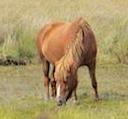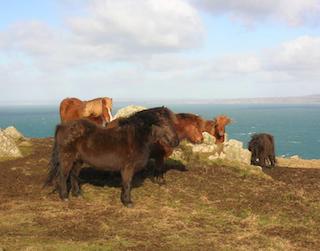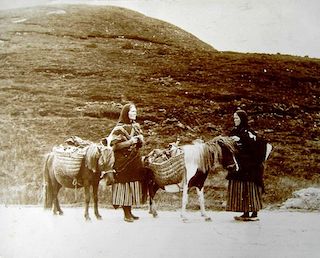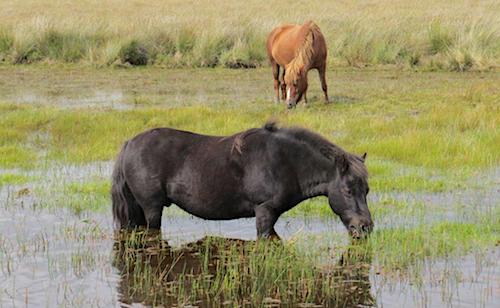 We might be at the other end of the land from the far northern isles, but you can still spot Shetland ponies on The Lizard, doing their bit for conservation.
We might be at the other end of the land from the far northern isles, but you can still spot Shetland ponies on The Lizard, doing their bit for conservation.
Photo: Steve Townsend
Scientific name: Equus ferus caballus (the scientific name for the domestic horse, of which Shetland Ponies are a breed)
Other common names: Sheltie (mainly used in Shetland), a name that also refers to a breed of Shetland sheepdog
Cornish name: Hoba is the Cornish word for a pony
What to look for:
- Appearance and colouring: Short and stocky, short legs, a thick mane and tail, and thick coat, especially in the winter months. Colouring is very varied, including black, chestnut and grey, as well as the less common skew- and piebald colouring.
- Size: Registered animals are up to a maximum 107 cm (or 10.2 hands), measured at the withers, but can be smaller, or even a little larger.
- Where: Shetland, across the UK, and in other countries and continents, such as the USA, where ponies were sent from the late nineteenth century for use in mining.
 When you’re out for an invigorating walk on one of our Lizard nature reserves, you may well come across some of our ponies, who have an important role to play in preserving biodiversity and supporting The Lizard’s rare fauna and flora.
When you’re out for an invigorating walk on one of our Lizard nature reserves, you may well come across some of our ponies, who have an important role to play in preserving biodiversity and supporting The Lizard’s rare fauna and flora.
One of the pony breeds you can see on The Lizard is the Shetland Pony. It might be small as horse species go, but is also strong – it can pull twice its own weight – and resilient, with its heavy, thick coat and short legs. This is exactly what you would expect from a breed that, since the Bronze Age (which dates from about 2000 BC in Britain), has lived a tough and harsh life in some of our northernmost isles. The earliest ponies on Shetland possibly arrived as migrants, descendants of Cob and Mountain Ponies from the south of Europe; the Celts and then Norse settlers probably also brought ponies to the islands, and cross-breeding resulted in the hardy animal we know today.
 Archaeological evidence certainly indicates that ponies were domesticated and put to work on Shetland from the Bronze Age onwards. In the succeeding centuries they were used to pull carts, transport peat and seaweed (used for fertilising crops), and for ploughing the fields: the photo, from the Shetland Museum’s Photographic Archive, shows two Shetland women with ponies in about 1900. Their small size also meant that, as the Industrial Revolution took hold in the nineteenth century, they were used as pit ponies, replacing child labour, which was banned from the middle of the century. They were transported and bred across Britain from this period, not just for the pits, but also as popular riding ponies for children.
Archaeological evidence certainly indicates that ponies were domesticated and put to work on Shetland from the Bronze Age onwards. In the succeeding centuries they were used to pull carts, transport peat and seaweed (used for fertilising crops), and for ploughing the fields: the photo, from the Shetland Museum’s Photographic Archive, shows two Shetland women with ponies in about 1900. Their small size also meant that, as the Industrial Revolution took hold in the nineteenth century, they were used as pit ponies, replacing child labour, which was banned from the middle of the century. They were transported and bred across Britain from this period, not just for the pits, but also as popular riding ponies for children.
No longer used for mining, the Shetland Pony appears in various modern settings, such as being used for children’s riding (including therapeutic riding) and harness driving (in competition and for pleasure). The Shetland is noted for its generally good-tempered nature, although they can show impatient and snappy characteristics. Since the end of the nineteenth century, the quality of the breed has been maintained through registration, such as with the Shetland Pony Stud-book Society. In order to be registered with the Society, a Shetland Pony should not be taller than 107 cm (or 10.2 hands), measured at the withers. Individuals can be much shorter – as small as 71 cm, or 7 hands.
They are, of course, also used for conservation grazing. This is the use of domesticated or semi-domesticated animals to graze in some habitats (including the heaths and grasslands found on The Lizard), keeping down the more vigorous vegetation and scrub and allowing therefore rarer, more delicate plants to get a foothold. Grazing also benefits animal and bird species, such as the Chough, which forages in short, cropped vegetation close to cliff tops. The hardy nature of Shetland ponies makes them a perfect choice for the windswept cliffs and heaths of The Lizard.
Did you know…?
…Our word pony comes from the French word for a foal – poulenet.
…On Shetland, fishermen at one time used pony tail hairs to make fishing lines.

Published: October 2017
Author: Amanda Scott
Photo: Two Shetland women and ponies, c. 1900 (Shetland Museum Photographic Archive); all other photos,Steve Townsend
